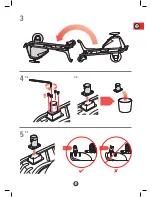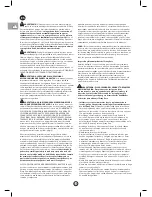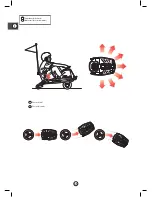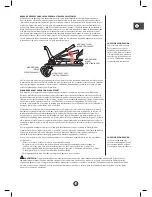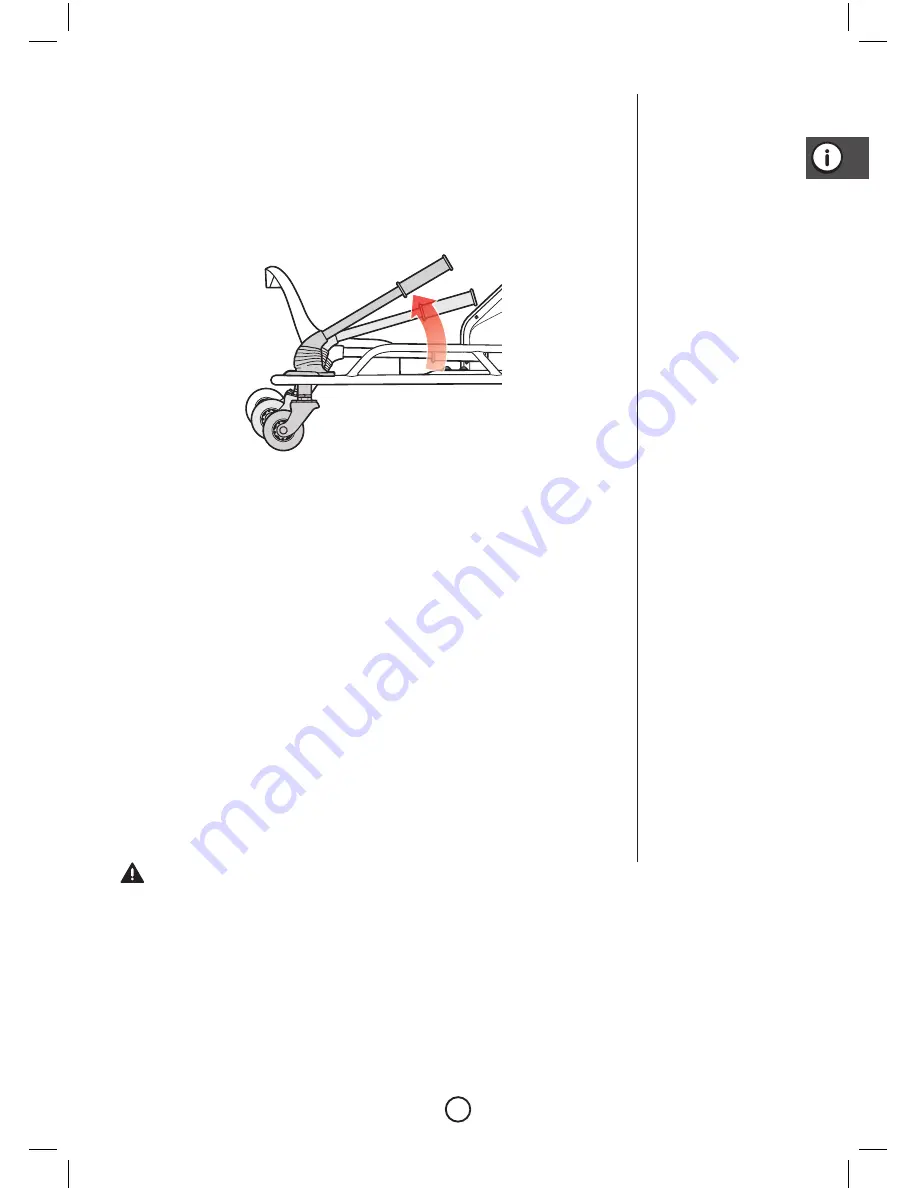
38
DRIFT BAR FOR ADJUSTABLE REAR CASTERS
The rear wheels on the Crazy Cart are mounted on casters, like RipStik wheels. By altering the angle of the
support for these wheels, the Crazy Cart can either “track” in the same direction as the drive wheel is going or
allow the rear end to “drift” in response to turning or acceleration forces. The Drift Bar allows control between
the two driving modes: normal mode for straight tracking (down or default) and Crazy Cart mode for drifting
(when the Drift Bar is pulled up). When the Drift Bar is in the down position, the Crazy Cart will track in-line
with the front wheel like a traditional vehicle. As the Drift Bar is raised, it changes the angle of the rear casters
and allows the rear of the cart to drift. The more the Drift Bar is raised, the easier the cart drifts. When the Drift
Bar is all the way up, the casters are in “Crazy Cart mode.” The Crazy Cart can thus actually turn itself around in
circles, and the size of the circle the cart will spin in depends on how much, if any, the Drift Bar is pulled up.
The higher the Drift Bar is, the tighter the circle the cart will spin in.
NORMAL MODE
(DEFAULT MODE)
CRAZY CART MODE
(DRIFTING MODE)
CRAZY CART MODE
(DRIFTING MODE)
NORMAL MODE
(DEFAULT MODE)
RIDING TIP: With the steering
wheel at 90°, the Crazy Cart will
move in a circle using the rear
inside caster as the “pivot point”
if the Drift Bar is down -- but
will rotate around its center if
the Drift Bar is fully raised.
In Crazy Cart mode, the frame is able to rotate any direction, regardless of the direction of travel. In the Crazy
Cart mode it is possible to drive in a straight line with the frame oriented any direction, including backwards
and sideways. The Drift Bar must be raised all the way up to travel backward in the Crazy Cart.
SPINNING, DRIFTING AND STOPPING THE CRAZY CART
The best use of the Crazy Cart involves careful coordination of the steering, the Drift Bar, and the accelerator.
The majority of spins and drifts that can be done in the Crazy Cart are accomplished by careful accelerator
control. Learning when to add or reduce power is the key to smoothly connecting tricks. Smooth riding
also increases the run time between charges. When first getting oriented with the Crazy Cart, it is highly
recommended that riders carefully apply the accelerator and take time to get familiar with the variable
effects of the Drift Bar and steering at low speeds.
There is no separate brake on the Crazy Cart, but with practice it is easy to stop. Of course, removing your foot
from the accelerator will slow the cart down as a result of friction in the drive train. To stop the Crazy Cart’s
forward motion immediately, take your foot off of the accelerator and turn the steering wheel 90 degrees to
either side. Removing your foot from the accelerator and turning the steering wheel will result in the Crazy
Cart spinning or drifting in a circle and slowing to a stop. By turning the steering wheel 90° and taking your
foot off the pedal, the rider can immediately arrest forward motion and instead turn away. In this way, the
Crazy Cart can avoid collisions and evade things otherwise in its path.
For your safety, take the time to get familiar and comfortable with various combinations of accelerator,
steering, and Drift Bar applications to learn how to slow down and how using the Drift Bar affects stopping at
slow speeds. Practice these skills for maximum rider safety.
These basic steering exercises may help to familiarize riders with their Crazy Cart’s capabilities:
1. First steer in a circle with the Drift Bar down.
2. Do the same circles, but raise the Drift Bar to different heights, and note how the chassis reacts to
drift differently based on lifts and steering.
3. Practice bringing the Crazy Cart to a stop by turning 90° to the left or right-- note how much more
tightly the Crazy Cart turns with the Drift Bar raised.
4. Practice staying “tucked in” in tight turns or spins.
RIDING TIP: The front stabilizer
posts help to keep your Crazy
Cart from tipping when you are
first stepping into the cart and
when you turn too hard.
WARNING: Recognize that these specialized riding features affect how the Crazy Cart functions and require extra caution and attention to
safe riding conditions and practices. Read and review the Safety Warnings on pages 29 and 30, and be extra careful with the Crazy Cart to avoid
traffic, obstacles and downhill environments. This is not a “bumper car” and is not designed to engage in collisions, jumping activities or for use
on surfaces other than hardened, smooth, flat and dry areas.
Summary of Contents for Crazy Cart
Page 2: ...1 1...
Page 3: ...36 PSI 250 kPa 1 6 1 1 1 1 2 2...
Page 4: ...2 4 3 5 6 HOURS MINUTES 5 1 5 2 1 1 2 3...
Page 6: ...3 7 5 6 4 8 1 1 5...
Page 7: ...8 12 10 11 9 13 6...
Page 8: ...14 18 16 17 15 1 2 2 7...
Page 9: ...19 22 21 20 8...
Page 10: ...23 25 24 2 2 2 9...
Page 11: ...26 29 27 28 10...
Page 12: ...30 32 31 3 3 3 11...
Page 13: ...33 34 35 12...
Page 14: ...1 7 1 5 mm 2 3 5 3 4 5 13...
Page 15: ...5 1 4 1 5 4 5 2 5 3 4 2 4 5 14...
Page 16: ...5 5 5 6 7 6 1 2 3 15...
Page 17: ...1 9 1 22 mm 5 mm 2 3 16...
Page 18: ...4 4 1 4 2 14 5 1 5 2 5 5 3 6 6 2 17...
Page 19: ...5 3 90 90 90 6 6 1 6 2 18...
Page 20: ...7 9 8 5 1 5 6 15 14 1 1 2 19...
Page 21: ...1 7 1 2 20...
Page 22: ...3 4 1 4 2 4 5 7 6 21...
Page 23: ...5 7 6 5 1 5 2 22...
Page 24: ...1 7 1 5 mm 2 3 4 5 23...
Page 25: ...3 4 1 5 1 4 2 4 5 24...
Page 26: ...7 6 5 2 2 1 1 25...
Page 27: ...2 3 1 10 1 26...
Page 28: ...4 7 6 5 8 9 1 27...
Page 29: ...9 10 28...
Page 34: ...2 1 1 2 1 2 33...
Page 35: ...2 1 2 1 34...

